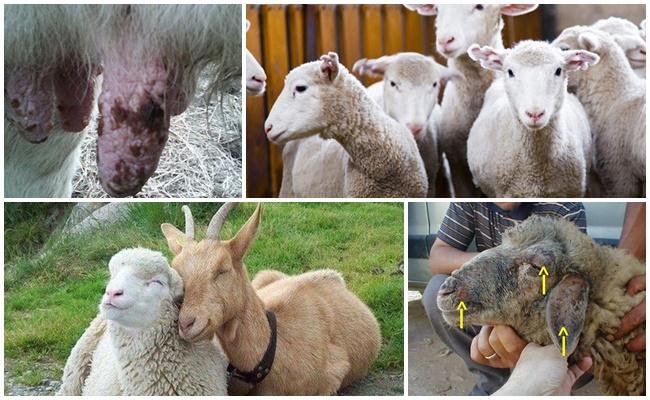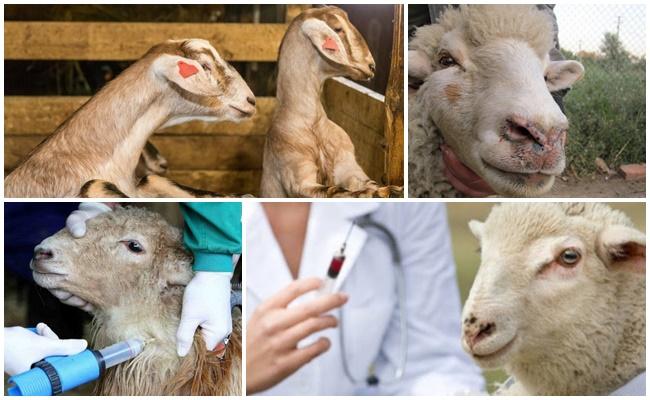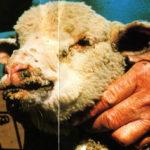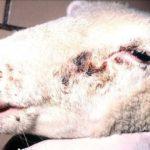Ways of infection and symptoms of smallpox in goats and sheep, treatment methods and consequences
People with sheep pox and domestic goats are usually sent for slaughter to prevent the spread of the virus. Only vaccination saves from this disease. Smallpox is transmitted through the air, contaminated particles, and direct contact. By grazing animals in fenced-off pastures, feeding them homemade food and drinking clean water, contamination can be avoided. It is advisable to keep the purchased breeding individuals imported from Asian countries in quarantine for a month.
Causative agent of the disease
Smallpox is a viral disease of goats and sheep that causes fever and rashes on the skin and mucous membranes. In Europe and Russia, this disease is rare and episodic, only when it is brought in by individuals from disadvantaged countries. Most often, smallpox affects animals in southern Asia and northern Africa. Smallpox disease Variola ovina belongs to group A, that is, rapidly spreading. Smallpox causes great damage to livestock production. Because of the disease, animals die, some have to be forced to be slaughtered.
The causative agent of the disease is a virus containing DNA. It belongs to the Poxviridae family and the Capripoxvirus genus. The virus is characterized by a relatively large size, epithelial properties and the ability to form round inclusions in cells. Smallpox virions have a complex structure. In the center they have a nucleus with a dumbbell-like core containing DNA. It is surrounded by a protein-lipid capsid and membrane.
The virus is very tenacious. It remains in the wool of recovered animals for two months. Indoors - six months. In dry smallpox crusts, the virus persists for 4-5 years. True, it dies in just 20 minutes at temperatures above +55 degrees. The virus is sensitive to alkalis and acids, formalin, ether and chloroform, phenol and detergents. One animal with smallpox can infect an entire herd in a short time (2-3 weeks). The incubation period is 4-12-21 days. Mortality is 5-10 sheep or goats out of 100.
The main routes of infection
The main source of infection is animals sick with smallpox. The virus enters the body of goats and sheep through the inhaled air, as well as through contact with diseased individuals. It disperses with drying and falling smallpox crusts throughout the territory. The spread of infection is facilitated by the transfer of sick animals from unfavorable areas to safe pastures. The virus can be transmitted through feed (grass), contaminated forage, bedding, vehicles and household items. Smallpox carriers can be insects in contact with sick animals.

Virus sensitivity varies by breed.Fine-wooled sheep are most susceptible to smallpox, while coarse-wooled sheep have a lower incidence rate. Older animals get sick less often than young ones. As for goats, dairy and fine-wool breeds are more sensitive to the virus. Most often, weakened animals kept in damp, cold and cramped rooms are sick.
The main symptoms
The smallpox virus is carried by the blood stream to the skin and mucous membranes. Pock marks form in these places. Smallpox exanthema goes through a series of successive stages. First, reddish spots appear, then they turn into nodules-papules, which after a few days are filled with a yellowish liquid.
Then the content darkens, becomes purulent. After a few days, the pockmarks dry up and form scabs, which subsequently disappear.
At the very beginning of the disease, goats and sheep lose appetite, body temperature rises slightly. In animals, the eyelids swell, there is discharge from the nose and eyes. Sick sheep and goats have difficulty breathing, sniffling. A smallpox rash appears on the head, around the eyes and mouth, on the genitals, and the udder. With a severe course, the pockmarks merge, affect large areas of the skin, which develops a purulent infection. There are even hemorrhages in smallpox foci. With an easy course of the process, the pock marks heal, that is, they turn into scabs, which subsequently disappear.
The illness usually lasts 3-4 weeks. Smallpox is joined by infectious inflammations, diseases of the gastrointestinal tract and lungs. Animals with weak immunity die from sepsis. Sheep and goats that tolerate mild smallpox recover and become immune to the disease. True, they can become carriers of the virus, which persists for a long time in their lymph, wool, and skin.
Diagnostic measures
The disease is mainly diagnosed on the basis of the clinical picture and laboratory data. For research, take the contents of pockmarks, altered skin areas. With an unclear course of the disease, bioassays are done. Smallpox is diagnosed using other methods (electronoscopy, RDP and RIF).
How to treat smallpox in goats
If signs of smallpox are detected, the sick animals are separated from the herd. They are given nutritious and light food. Potassium iodide is added to drinking water. Patients are given pharmacy vitamins, minerals, immunostimulants. Infectious complications are treated with antibiotics (penicillin). Pockmarks on the skin are burned with iodine, brilliant green, potassium permanganate, antiseptics. The disease goes away on its own after 20 days. Severely ill goats and sheep are killed.

Consequences of the disease
Cured mildly animals receive immunity from smallpox for 2 years. Disease in 5 percent out of 100 can be fatal. Smallpox is very dangerous for young animals. Recovered animals may lag behind in growth and development. The meat of seriously ill goats and sheep is forbidden to be used for food purposes. If you suspect smallpox, notify your local veterinarian.
Prevention
As a preventive measure, healthy animals are vaccinated with an aluminum hydroxide formol vaccine. After vaccination, sheep and goats receive immunity after 10 days, that is, protection against smallpox for 6-12 months. The vaccine has no therapeutic effect, only a preventive effect. Vaccinations can be given to both adult animals and young animals. The smallpox vaccine is completely harmless. The vaccine is prescribed even to females who have given birth, whose young with colostrum will receive immunity from a dangerous viral disease.

Virus infection can be prevented by keeping sick sheep or goats out of pastures.It is forbidden to buy feed, grain, compound feed and breeding animals in disadvantaged areas. It is advisable to keep newly purchased animals separately from the main herd for 30 days. If smallpox is suspected, they are usually sent to the slaughter.
Rooms where sick sheep or goats were kept must be thoroughly disinfected. For disinfection, lime, chlorine-containing solutions are used. It is recommended to burn the corpses in special crematoria or bury them far from pastures.
It is forbidden to use the manure of sick individuals for agricultural needs without disinfection. The meat of the recovered sheep and goats is not recommended for food. The wool and skins of recovered animals must be decontaminated with acids or high temperatures. It is better to send sick individuals immediately to the slaughter, and burn the corpses entirely. Such a radical way of dealing with smallpox will help protect the rest of the livestock from infection and dangerous disease.












